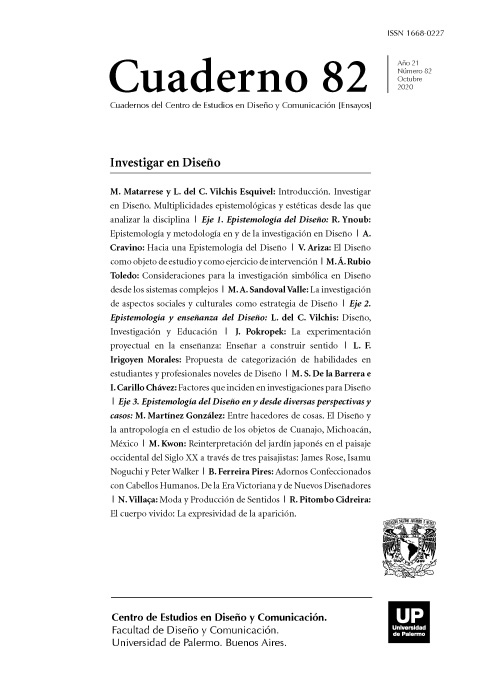Entre hacedores de cosas. El Diseño y la antropología en el estudio de los objetos de Cuanajo, Michoacán, México
Abstract
Abstract: Local objects, produced in rural or indigenous communities –handcrafts– have special interest for designers and anthropologists, but the way in which these disciplines approach this subject is very different. The main purpose of this paper is to explore new ways to integrate Ethnography in the design process, and to use Design to get anthropological knowledge, in the context of Michoacán, Mexico. This research has a qualitative approach, and results from one year of fieldwork in a town recognized for its speciality in the production of wood furniture and textiles. The research is based on two study cases in which we look for new ways to make and know about a rural community in Mexico; for the first one, we built an image to understand the relationship between people and objetcts; on the other case we introduced ethnographic fieldwork to the design process.
References
Aguilera, C., et.al (1985). El mueble de madera mexicano. Historia, evolución e influencias, México: Centro Cultural Banamex.
Anastassakis, Z., Szaniecki, B., Ibarra, M.C., Mota, C., Medeiros, I., Oliveira, M., Sirito, M. y Costard, M. (2016). “Design and its movements in times of a widespread participation”. En: PDC ´16: Proceedings if the 14th Participatory Design Conference: Short Papers, Interactive Exhibitions, Workshops - Volume 2 (pp- 84-85), Aahrus, Dinamarca: ACM.
Ardèvol, E. (1998). “Por una antropología de la mirada: etnografía, representación y construcción de datos audiovisuales”. En: Revista de Dialectología y Tradiciones Populares, vol. LIII, núm. 2 (pp. 217-240), España: Consejo Superior de Investigaciones Científicas. Censo de Población y Vivienda, 2010 . http://www.beta.inegi.org.mx/ (visitada en agosto del 2016).
Clarke, A. (2011). Design anthropology: object culture in the 21st century. Viena: Springer.
De Fusco, R. (1997). Storia del Design. Roma: Editori Laterza.
Ingold, T. (2015). Líneas, una breve historia. Barcelona: Gedisa.
Ingold, T. (2014). “That´s enough about ethnography!”. En: Journal of Ethnographic Theory, vol. 4 (pp. 383-395). London: Creative Commons.
Ingold, T. (2013). Making. Anthropology, archaeology, art and architecture. Nueva York: Routledge.
García Canclini, N. (1984). “Investigación y política artesanal: propuestas metodológicas”. En: Boletín de Antropología Americana, núm. 9 (pp. 127-134), México: Instituto Panamericano de Geografía e Historia.
Giménez, G. (1997). “Materiales para una teoría de las identidades sociales”. En: Frontera Norte, vol. 19, núm. 18 (pp. 9-28), México: El Colegio de la Frontera Norte.
Gatt, C. e Ingold, T. (2013): “From Description to Correspondence: Anthropology in Real Time”. En: Gunn, Wendy, Ton Otto y Rachel Charlotte Smith (Ed.): Design Anthropology. Theory and Practice (pp. 139-158), Londres: Bloomsbury.
Gunn, W., Otto, T. y Smith, R. (2013). Design Anthropology: Theory and Practice. London: Bloomsbury Academic.
Gunn, W. y Donovan T. (eds) (2012). Design and Anthropology. Farnham: Ashgate.
Gunn, W. y Løgstrup, L. (2014). “Participant observation, anthropology methodology and design anthropology research inquiry”. En: Arts & Humanities in Higher Education, vol. 13 (pp. 428-442 ). Reino Unido: SAGE Publications.
Hagerman, O (2012). http://www.arquine.com/conferencistas/oscar-hagerman/ (visitada en marzo del 2017)
Heuson, J. y Allen, K. (2014) “Asynchronicity: Rethinking the Relation of Ear and Eye in Ethnographic Practice”. En: Schneider A. y Pasqualino, C. (Ed.), Experimental Film and Anthropology (p. 113-130). Londres: Bloomsbury. Laboratório de Design e Antropologia, Universidade do Estado do Rio de Janeiro.https://www.facebook.com/lada.esdi/ (visitada en octubre del 2017). Línea de investigación “Cruces entre cultura y Diseño”, Universidad de Palermo, Argentina. http://www.palermo.edu/dyc/investigacion_desarrollo_diseno_latino/cruces_entre_cultura_diseno.html (visitada en octubre del 2017).
Martín Juez, F. (2002). Contribuciones a una antropología del Diseño. Barcelona: Gedisa.
Novelo, V. (2002). “Ser indio, artista y artesano en México”. En: Espiral. Estudios sobre Estado y Sociedad, vol. XIX, núm. 25 (pp. 165-178), México: Universidad de Guadalajara.
Nuño Gutiérrez, R. (2015). Cuanajo. Discursos de una identidad. México: Universidad de Guadalajara. Rabinow, P.,
Marcus, G., Faubion J., Rees, T. (2008) Designs for an Anthropology of the Contemporary. EUA: Duke University Press.
Ramírez, A. (2006). Tejiendo la identidad. El rebozo entre las mujeres purépechas de Michoacán (tesis de maestría). México: El Colegio de Michoacán.
Ramírez, A. (2014) Tejiendo la identidad. El rebozo entre las mujeres purépechas de Michoacán. México: Dirección General de Culturas Populares.
Ramírez, A. (Ed.) (2012). Diseño e iconografía de Michoacán: geometrías de la imaginación. México: Dirección General de Culturas Populares.
Rose, G. (2007). Visual Methodologies. An Introduction to the Interpretation of Visual Materials. London: SAGE Publications.
Otto, T. y Smith, CH. (2013) “Design Anthropology: A Distinct Style of Knowing”. En: Gunn, W., Otto, T. y Smith, CH. (Ed.), Design Anthropology. Theory and Practice. London: Bloomsbury Academic.
Smith, Ch., y Otto, T. (2016) “Cultures of the Future: Emergence and Intervention in Design Anthropology”. En: Smith, Ch., Vangkilde, K., Kjaersgaard, M., Otto, T., Halse, J., Binder, T. (Ed.), Design Antrhopological Futures (p.19-36). United Kingdom: Bloombsbury.
Turok, M. (1998), Como acercarse a la artesanía. México: Editorial Plaza y Valdés.
Whitford, F. (1994) (director): Less is more. Londres: BBC.
Los autores/as que publiquen en esta revista ceden los derechos de autor y de publicación a "Cuadernos del Centro de Estudios de Diseño y Comunicación", Aceptando el registro de su trabajo bajo una licencia de atribución de Creative Commons, que permite a terceros utilizar lo publicado siempre que de el crédito pertinente a los autores y a esta revista.


